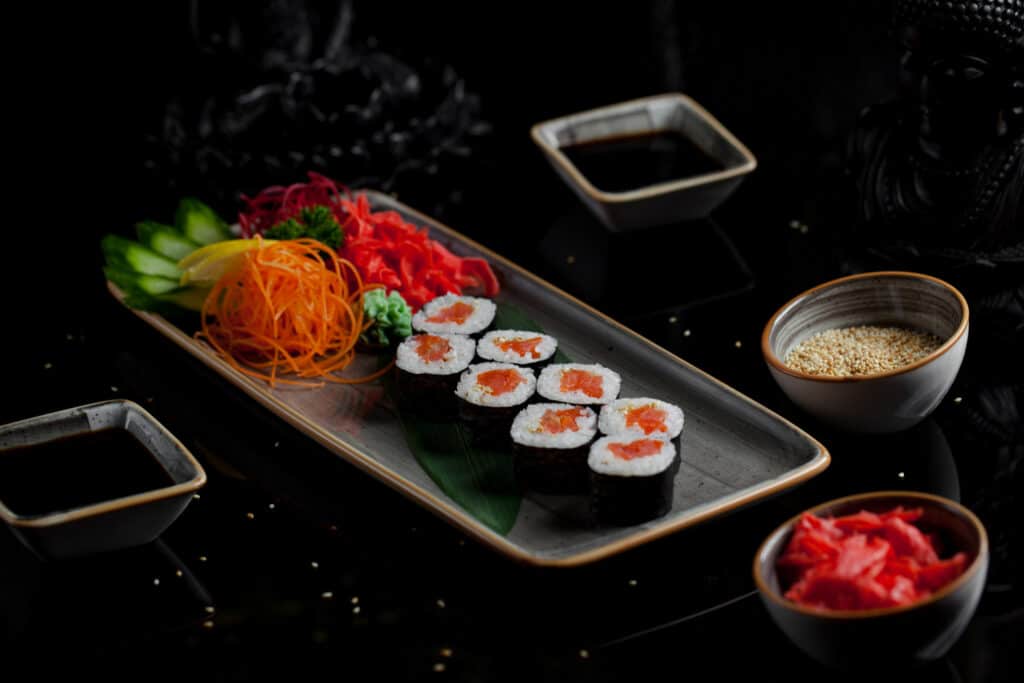Have you ever heard about the famous Korean food Gimbap? I am sure you must, and if not, then you’re in for a treat. Today, we are going to take you on a delightful Gimbap Korean adventure. Gimbap, also known as Yachae Kimbap, is a special Korean food. It combines a delightful mixture of ingredients wrapped in sheets of seaweed. In this culinary adventure, you’ll learn about the step-by-step guidelines for preparing Gimbap. Get ready to roll and discover the joy of making this delectable Korean dish.
What Is Kimbap (Or Gimbap)?
Kimbap, or gimbap, is often called the Korean version of sushi.
Kimbap holds a special place in Korean culture. It is a symbol of inventiveness arising from its origins as a portable meal for laborers and travelers. Today, it continues to be a loved part of Korean cuisine. This dish adds grace to the tables at celebrations, festivals, and family gatherings. This cherished culinary creation sums up the essence of Korean cuisine. Beyond its similarities with sushi, it is filled with unique ingredients. Its uniqueness sets it apart as a flavorful and accessible dish in its own right.
Types of Gimbap Korean
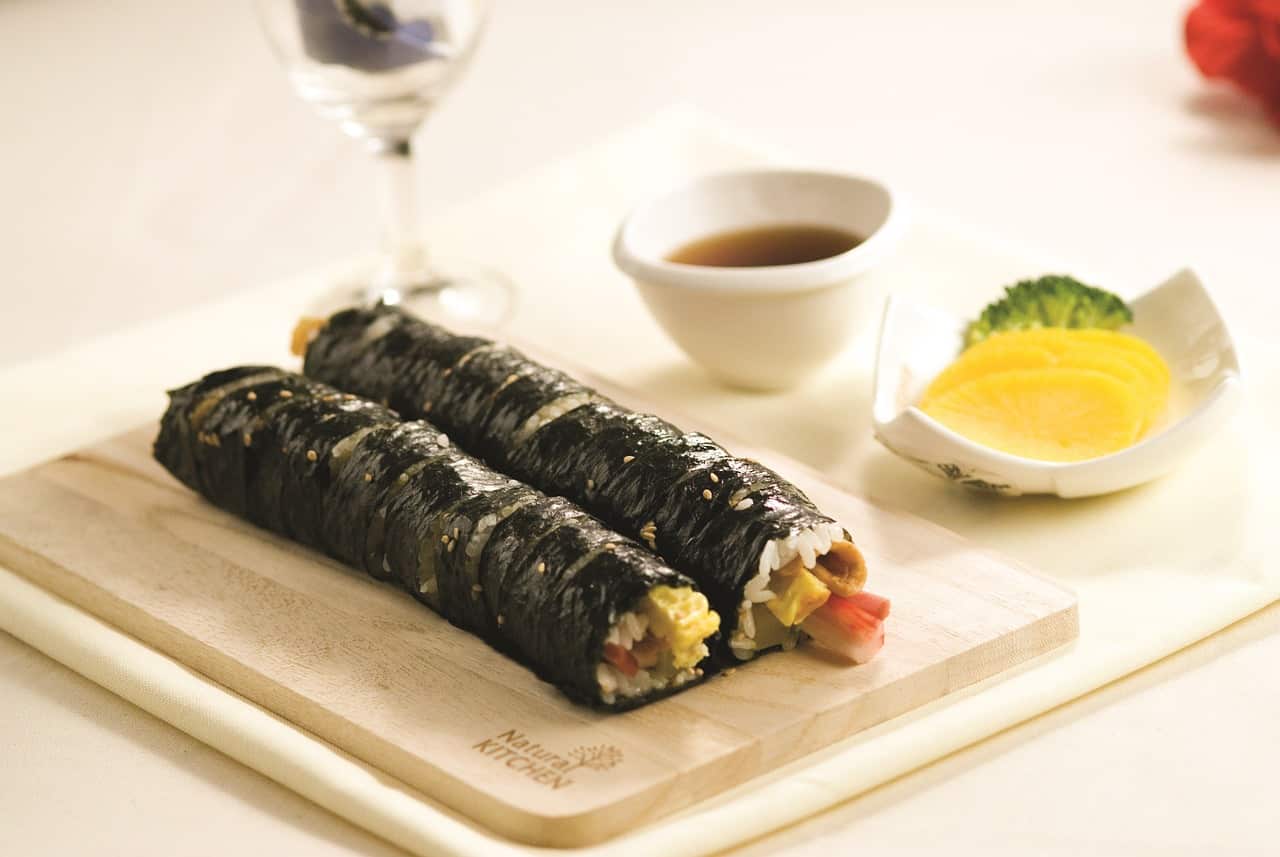
Gimbap is a hit when it comes to Korean picnic food. It is a beloved Korean dish that comes in various types and flavors. catering to a wide range of tastes and preferences. Here are some popular types of gimbap:
Classic Gimbap
Everyone loves this gimbap. It’s full of colorful veggies like carrots, cucumbers, and spinach, along with some cooked beef or crab for extra flavor. The combination of these ingredients creates a delicious and balanced roll. It’s fresh, healthy, and offers a garden-fresh taste.
Tuna Mayo Gimbap
Imagine creamy tuna mixed with mayonnaise inside the roll. It’s like a smooth and decadent treat that’s also quite filling. It’s taste will knock your socks off.
Tofu Gimbap
If you’re a fan of tofu, you’ll enjoy this Gimbap. It features slices of tofu that are usually pan-fried until they’re crispy and golden. The tofu brings a unique texture and mild, comforting taste to the roll.
Kimchi Gimbap
If you enjoy a little spicy and tangy kick, this one’s for you. Kimchi is a spicy fermented cabbage that gives the Gimbap a bold and exciting flavor.
Egg Gimbap (Gyeran Mari)
This is the vegetarian version of Gimbap and is perfect for vegetarians. They have slices of fluffy, yellow egg omelet mixed with fresh veggies and rice. It’s gentle and comforting on the taste buds.
Mangchi Gimbap
This Gimbap is named after the Korean word for hammer. As it’s all about the bold flavors. It often includes spicy bulgogi (marinated beef). The thing beef slices with a special spicy sauce gives it a real kick. It’s perfect for those who love their food with some heat.
Chamchi Gimbap (Spicy Tuna Gimbap)
The Chamchi gimbap is for heat lovers. Spicy tuna adds an exciting flavor to the meal. It’s a bit spicy but delicious.
Mayak Gimbap (Drug Gimbap)
These are tiny Gimbap rolls that you might find addictively delicious. They’re drizzled with a sweet and savory soy sauce that’s like a special treat.
Samgak Gimbap Korean
Samgak Gimbap is unique because it’s shaped like a triangle. It’s convenient for snacks or lunch. It is filled with various ingredients, all wrapped in seaweed.
Fruit Gimbap
If you’re in the mood for something sweet and fresh, then you can have fruit Gimbap. This gimbap includes ripe fruits like strawberries or mangoes mixed with seasoned rice and seaweed. It’s like a tasty blend of familiar and exotic flavors.
Ingredients of Gimbap Korean
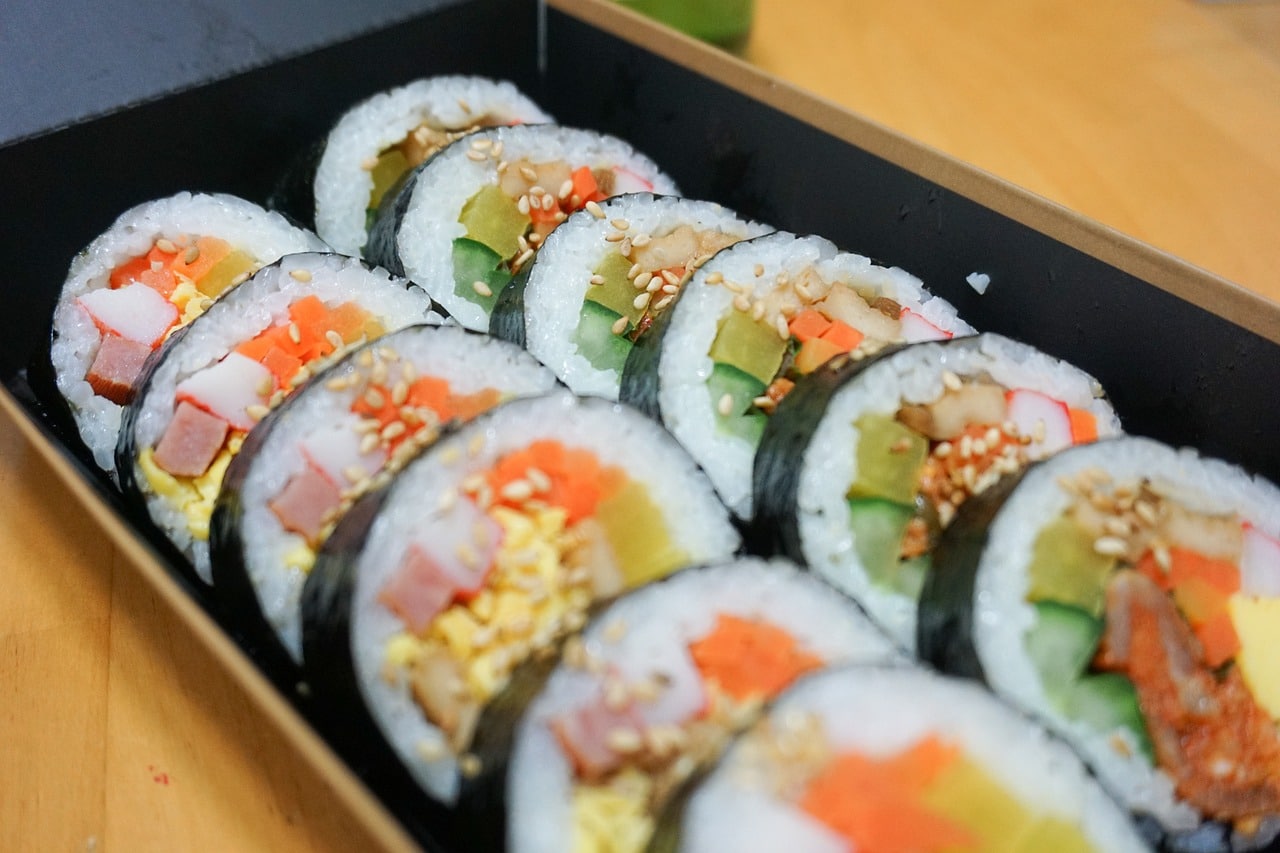
These ingredients provide a wide range of options to create various Gimbap recipes, from traditional to inventive. You can mix and match fillings and seasonings to suit your taste preferences and dietary choices, making Gimbap a versatile and customizable dish.
-
Seaweed Sheets (Nori or Kim)
These are thin sheets of seaweed used as the outer wrapping for Gimbap.
-
Steamed Rice
Short-grain white rice, often seasoned with a mixture of salt, sugar, and sesame oil for flavor.
-
Seasoning Ingredients
- Salt
- Sugar
- Sesame oil
-
Fillings (Vegetables)
- Carrots (julienned or thinly sliced)
- Cucumber (cut into long strips)
- Spinach (blanched and seasoned)
- Pickled radish (danmuji)
- Avocado slices (for a creamy twist)
-
Fillings (Proteins)
- Cooked beef (bulgogi)
- Tuna mayo (canned tuna mixed with mayonnaise)
- Cooked crab meat
- Egg omelet strips
- Tofu (pan-fried or grilled)
-
Additional Fillings (Optional)
- Kimchi (spicy fermented cabbage)
- Pickles (such as dill pickles or pickled plums)
- Sweet potato noodles (japchae)
-
Dipping Sauce Ingredients
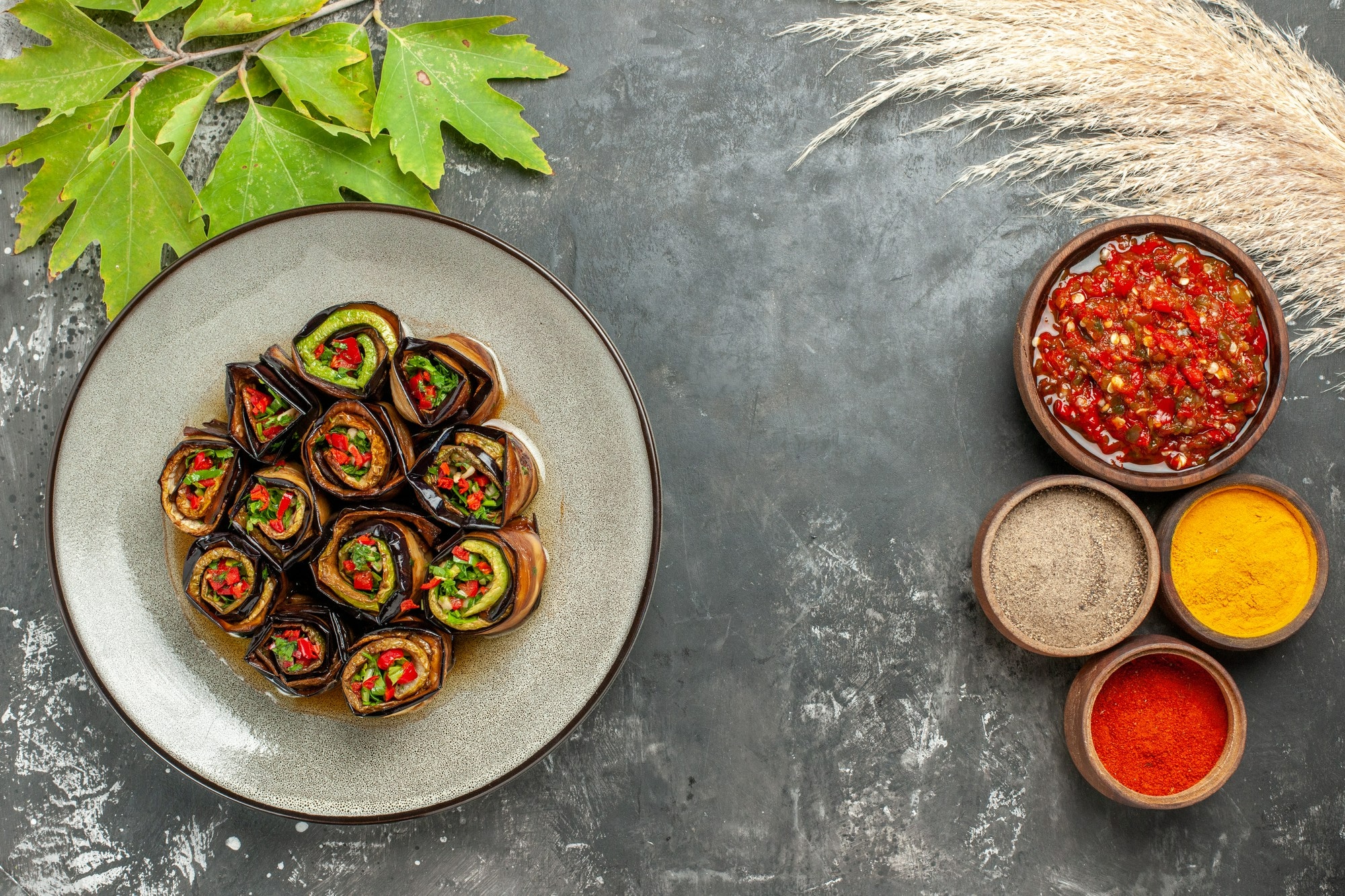
- Soy sauce
- Sesame oil
- Sugar
- Wasabi (optional)
- Mustard (optional)
-
Mini Gimbap Sauce (Mayak Gimbap)
- Soy sauce
- Sugar
- Vinegar
- Minced garlic
- Sesame seeds
-
Fruit Gimbap Ingredients (Sweet Version)
- Fresh fruits (strawberries, mango, etc.)
- Seasoned rice
- Honey (for drizzling, optional)
-
Garnishes (Optional)
- Sesame seeds (white or black)
- Roasted seaweed flakes (gim garu)
- Korean red pepper flakes (gochugaru, for a spicy kick)
Kitchen Tools Needed To Make Yummy Gimbap Korean
Kitchen tools and equipment are also important things to prepare and serving Gimbap at home. So, take the right tools to make the process smoother and for delicious results.
- Bamboo Sushi Rolling Mat (Makisu)
- Plastic Wrap or Plastic Food-Grade Gloves
- Sharp Knife
- Cutting Board
- Rice Cooker (Optional)
- Large Mixing Bowl
- Spatula or Rice Paddle
- Sauce Mixing Bowl (for dipping sauce)
- Plastic Wrap or Aluminum Foil
- Large Pot (for blanching vegetables)
- Frying Pan (for cooking proteins like bulgogi or omelet)
- Rice Spatula or Wooden Spoon
- Small Brush (for applying sesame oil)
- Plates or Platters
Step By Step Preparation Of Gimbap Korean
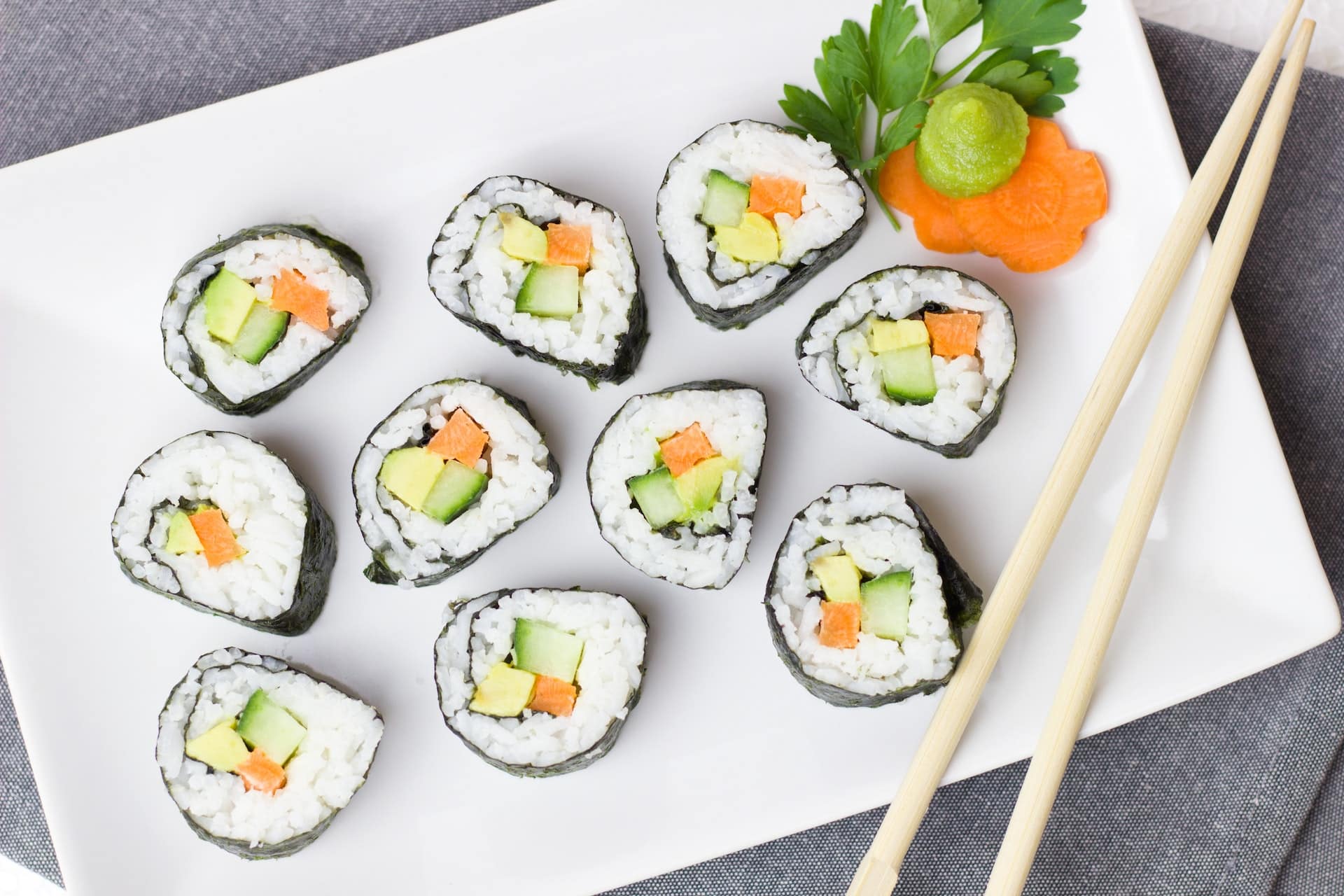
- Prepare the Ingredients. Gather all the ingredients you’ll need, like seaweed sheets, cooked rice, various fillings (vegetables, proteins, and any optional ingredients), and the seasoning ingredients (salt, sugar, and sesame oil).
- In a large mixing bowl, mix cooked rice with a pinch of salt, a bit of sugar for sweetness, and a drizzle of sesame oil for flavor. Gently mix it all together. The rice should be slightly sticky and glossy.
- Prepare your fillings by cutting them into thin strips or bite-sized pieces. You can blanch the vegetables if needed and have them ready.
- Place the bamboo sushi rolling mat (makisu) on a clean and flat surface. You should cover it with plastic wrap to prevent sticking.
- Lay a sheet of seaweed (nori) on the bamboo mat. Make sure the shiny side is facing down and the rough side is up.
- Wet your hands slightly to prevent the rice from sticking. Take a handful of rice and gently spread it evenly over the seaweed. There is a tip that leave about half an inch of seaweed at the top edge.
- Arrange your chosen fillings on top of the rice. You can get creative with the combinations but don’t overfill. It will e hard to roll.
- Start rolling the Gimbap by lifting the edge of the bamboo mat closest to you. Use it to tuck the seaweed over the fillings. After that gently roll the mat away from you. Applying light pressure to shape the Gimbap into a cylinder.
-
Additional Tips
- Moisten the top edge of the seaweed with a little water to help it seal. Continue rolling until you have a tight cylinder. Press the seam to seal the Gimbap.
- With a sharp knife, slice the rolled Gimbap into bite-sized pieces. To prevent sticking, you can dip the knife in water occasionally. Arrange the slices on a plate or platter.
- All this process without a dip dish is incomplete. Prepare a dipping sauce by mixing soy sauce, sesame oil, sugar, and optional ingredients like wasabi or mustard. Serve the Gimbap slices with the dipping sauce on the side.
Now you must be having watery mouth to have gimbap. So hurry up and follow the recipe of Gimbap to enjoy it as a delicious snack, lunch, or appetizer. The combination of flavors and textures is sure to satisfy your taste buds. If you are lazy enough, we still got your back. Visit Fresh elements restaurant and have a meal of your life.


